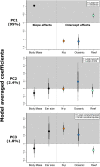Quantitative assessment of inner ear variation in elasmobranchs
- PMID: 37488259
- PMCID: PMC10366120
- DOI: 10.1038/s41598-023-39151-0
Quantitative assessment of inner ear variation in elasmobranchs
Abstract
Considerable diversity has been documented in most sensory systems of elasmobranchs (sharks, rays, and skates); however, relatively little is known about morphological variation in the auditory system of these fishes. Using magnetic resonance imaging (MRI), the inner ear structures of 26 elasmobranchs were assessed in situ. The inner ear end organs (saccule, lagena, utricle, and macula neglecta), semi-circular canals (horizontal, anterior, and posterior), and endolymphatic duct were compared using phylogenetically-informed, multivariate analyses. Inner ear variation can be characterised by three primary axes that are influenced by diet and habitat, where piscivorous elasmobranchs have larger inner ears compared to non-piscivorous species, and reef-associated species have larger inner ears than oceanic species. Importantly, this variation may reflect differences in auditory specialisation that could be tied to the functional requirements and environmental soundscapes of different species.
© 2023. The Author(s).
Conflict of interest statement
The authors declare no competing interests.
Figures







Similar articles
-
Interspecific Variation in the Inner Ear Maculae of Sharks.Integr Org Biol. 2023 Sep 4;5(1):obad031. doi: 10.1093/iob/obad031. eCollection 2023. Integr Org Biol. 2023. PMID: 37732173 Free PMC article.
-
Ontogeny of the inner ear maculae in school sharks (Galeorhinus galeus).Hear Res. 2022 Oct;424:108600. doi: 10.1016/j.heares.2022.108600. Epub 2022 Aug 30. Hear Res. 2022. PMID: 36087420
-
A comparison of the external morphology of the membranous inner ear in elasmobranchs.J Morphol. 2010 Apr;271(4):483-95. doi: 10.1002/jmor.10812. J Morphol. 2010. PMID: 20058296
-
Diversity of Inner Ears in Fishes: Possible Contribution Towards Hearing Improvements and Evolutionary Considerations.Adv Exp Med Biol. 2016;877:341-91. doi: 10.1007/978-3-319-21059-9_16. Adv Exp Med Biol. 2016. PMID: 26515322 Review.
-
Do electromagnetic fields from subsea power cables effect benthic elasmobranch behaviour? A risk-based approach for the Dutch Continental Shelf.Environ Pollut. 2024 Apr 1;346:123570. doi: 10.1016/j.envpol.2024.123570. Epub 2024 Feb 14. Environ Pollut. 2024. PMID: 38360387 Review.
Cited by
-
The biophysics of water in cell biology: perspectives on a keystone for both marine sciences and cancer research.Front Cell Dev Biol. 2024 May 13;12:1403037. doi: 10.3389/fcell.2024.1403037. eCollection 2024. Front Cell Dev Biol. 2024. PMID: 38803391 Free PMC article.
-
Case report: Endolymphatic system disease in elasmobranchs: clinical presentation, diagnosis, and treatment strategies.Front Vet Sci. 2025 Mar 10;11:1463428. doi: 10.3389/fvets.2024.1463428. eCollection 2024. Front Vet Sci. 2025. PMID: 40129653 Free PMC article.
References
-
- Retzius G. Das gehörorgan der fische und amphibien. Samson and Wallin; 1881.
-
- Ladich F, Schulz-Mirbach T. Diversity in fish auditory systems: One of the riddles of sensory biology. Front. Ecol. Evol. 2016;4:1–26. doi: 10.3389/fevo.2016.00028. - DOI
-
- Schulz-Mirbach T, Ladich F. Diversity of inner ears in fishes: Possible contribution towards hearing improvements and evolutionary considerations. In: Sisneros JA, editor. Fish Hearing and Bioacoustics. Advances in Experimental Medicine and Biology. Springer; 2016. pp. 341–391. - PubMed
-
- Popper AN, Coombs S. The morphology and evolution of the ear in actinopterygian fishes. Am. Zool. 1982;22:311–328. doi: 10.1093/icb/22.2.311. - DOI
-
- Platt C, Popper AN. Fine structure and function of the ear. In: Tavolga WN, Popper AN, Fay RR, editors. Hearing and Sound Communication in Fishes, Proceedings in Life Sciences. Springer; 1981. pp. 3–38.
Publication types
MeSH terms
LinkOut - more resources
Full Text Sources

